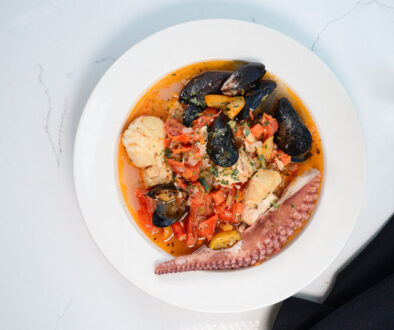Murder, She Spoke
There’s an intriguing Instagram account called Zillow Gone Wild. Not to be confused with the regular old Zillow feed, which is a platform for real estate sales, the hook of Zillow Gone Wild is that you never know what goes on behind closed doors. The lead exterior photo might be of your standard white split-level or a run-of-the-mill brick colonial, but inside you’ll find anything from fluorescent purple ceilings to a putting green to floor-to-ceiling cherubic murals.
This concept carries over into the crime world, where it’s become somewhat of a trope to say, “He seemed like such a normal guy!” about a person who’s committed murder. That disconnect between the neighbor you might wave to each morning and the unthinkable is something that fascinates us as a society, and from that fascination springs the true crime podcast genre. Worldwide, just under 465 million people listen to podcasts, and about 25% of those podcasts are true crime. According to a Pew Research study published in June, the number of podcast listeners has increased significantly over the past decade, from just 12% of Americans listening to a podcast in the previous 30 days in 2013, to 42% of Americans who do now. And gentlemen, take this how you will, but most of those true crime listeners are women.

In the past six years, over 200 true crime podcasts have launched – and one of those has been right here in Cape May County. Holly Knapp and Leslie Weidel launched We Would Be Dead in February of 2020, where they bring their differing yet complementary perspectives to the microphones. You may recognize or even know one of these women via their other local endeavors. Holly has been active in local and regional theater, as both an onstage artist and as a writer and artistic director for well over a decade. Leslie is an entrepreneur, co-owner of Shore Soaps, and is married to local musician Jon Katity. The pair have tapped his composing and editorial skills to provide the backdrop and theme music for the podcast.
We caught up with this creative entrepreneurial duo to see how they work together, and to get their thoughts on all things true crime podcasts. When I confessed that I don’t listen much to podcasts in general because I have to stop what I’m doing to focus on it, not unlike watching television, they pronounced me an anomaly. “Most of our feedback is ‘I had to clean out my shed, and listened to six hours of back-to-back episodes, so thank you for that,’” Holly said. “A lot of people listen while they’re doing things like driving or household chores.” Most of this feedback comes in the form of social media, where their followers are affectionately referred to as “fiends,” a play on “friends.”
So, how did this happen? Holly, an avid podcast listener who by her own admission has been a true crime aficionado “since I was a creepy little kid,” posted on Facebook that as a New Year’s resolution, she wanted to start a podcast of her own. “She said she had an idea for it and that she thought it could be really good,” Leslie (who is also her cousin), said. “I could tell, though, that she might not be able to swing this on her own, and that’s where I come in. I have this attitude where I just want everybody to succeed. My husband calls me the campaigner.”
“A lot of this also came about because Leslie and I had many lengthy text conversations about true-crime documentaries, some of which she recommended to me,” Holly added. “I would be watching, and it would be this constant stream of texting throughout. After a couple of these, it became ‘We could definitely do this, because we’re kind of doing it already.’ Although I knew I could handle it by myself in terms of the writing and the research, never mind all the stuff that already lives in my head, most true-crime podcasts consist of two people talking back and forth, so once Leslie said let’s do it, we were on.”
Jon was pulled in on the technical aspects, and Holly says, “I think it became real for us when Jon said ‘Oh, I wrote your theme song.’ Will (Holly’s husband, Will Knapp, who works in tech as well as being a local musician), helped get us set up on some of the technical stuff, and Jon edits all our podcasts as well.”
The fact that Jon is also a fan of the horror genre “and loves all things storytelling,” said Leslie, made the whole thing really come together. “He composes the background music and sound effects for Holly’s monologues, and that’s really the art for the show. I feel like it sets us apart a bit.”
The present podcast structure developed over time. It opens every week with a 15-minute or so original short story that Holly writes, which is tangentially related to that week’s topic. It’s fully scored with Jon’s music, the idea being to set the scene, and create “an immersive feeling” before the podcast begins. “[Jon and I] get to go a bit off leash in setting up that moody vibe to open the show, to set the scene,” Holly said.
A tremendous amount of research goes into each show. “We have to be at least a little topical,” Holly said. “What people want to hear about is what they are searching for online, and typically, that’s whatever’s in the news. It’s either that, or it’s something that’s more ‘classic.’ For instance, you will forever have people who are interested in Ted Bundy, Jeffrey Dahmer, the Black Dahlia case—all of which we’ve covered.”
Holly said the issue with covering things that are presently in the news is that there’s a delicate balance to be struck. “For instance, a girl who was recently missing was found okay, but there was so much media attention that she fled again. We don’t want to be that. We don’t want to hurt; we want to help.” Instances such as this have caused the team to pivot on a dime. “We have literally changed stories within a day,” Leslie says. “We’ll have a fully written show that’s ready to go and something will happen and we’ll say, ‘We can’t go with this now.’ And then we’ll start from scratch.”
If you’re new to their podcast—or the true-crime genre in general—Holly said she has a go-to episode she points to for potential fiends. “I always send them to our episode about Elmer McCurdy, because it’s not only not as heavy as some of our other stuff, but it’s a story that not many people know, and we had a lot of fun talking about it.” McCurdy was a failed train robber, who then went on the run and was shot by police. “But that’s not the interesting part of the story,” Holly said. “His body was never claimed by his family, so the funeral home put it on display and charged people a dime to see it. It was then toured in sideshows, featured as a prop in movie openings, and ultimately ended up in a haunted house on a California beach. It was discovered there by the crew of the television series The Six Million Dollar Man.”

This episode has “all the elements,” but is not particularly scary or gruesome. “And if people like that one, it might lead them to more of our heavier stuff,” Holly said. The duo has differing takes on what the heaviest of their “heavy” episodes is— “And it’s going to be different for everyone, I think.”
“I can’t handle anything related to home invasions, so I think my least favorite was the Daniel LaPlante episode,” says Leslie. For Holly, “As famous as it is, I did not enjoy covering Jeffrey Dahmer. It is so ubiquitous, and fascinates people, and the recent series on Netflix had everyone talking. But when I’m talking about these people, I don’t use their full names, or any title they’ve been given, like ‘the Night Stalker.’ When I talk about Jeffrey Dahmer, he’s Jeff. Because Jeff is a guy, but Dahmer is a monster. Same with Ted Bundy—he was Ted because that’s how the women he killed knew him.”
It’s not all doom and gloom on WWBD. “We do some fun ones—we did an episode on the Jersey Devil,” Holly said. Another major connection the two women share is they are both big fans of the Victorian era. “Often when we’ve done several dense stories or heavy stories in a row, we’ll revert back to Victorian times for something ‘old and weird,’” Leslie said. “’Old and weird’ is like a subcategory for us,” Holly adds with a laugh. They tell traditional Victorian ghost stories live on Christmas Eve, and last year on Halloween, they spoke with Tony Moran, one of the original actors to play horror movie icon Michael Myers.
“Those tend to be the ones we have the most fun with, and we get to laugh,” Leslie said. “But we also get to be educational, and we are Cape May girls at heart.” The educational aspect comes about, according to Holly, by another thing they feel sets their podcast apart. “Rabbit holes. We go down rabbit holes. If we mention a mental health term in a story, for instance, we don’t just go past it. We’ll tell you what it is, and where it came from, and who first diagnosed it.” So, all those little things that you might Google while listening to another podcast? “They’re Googled for you. That’s always really fun, and it also serves to break up the straight line of ‘awful’ that can be most of these cases. And sometimes the things that are connected to the main story are also just as interesting as the [main] story we’re telling. It becomes just this extra pocket of information. So, it goes from ‘oh, I heard this really sad story’ to ‘but I also learned about this weird old-timey disease, or the origins of this word!”’
Leslie contributes to this aspect by doing a tangential bit about the pop culture of the time in which the episode takes place, or the fashion trends of the day. “The fun parts,” according to Holly. This points out one of the most interesting aspects of the dynamic between the two hosts. There is a yin-yang in play between them; Holly, with her theatrical presence, goth background, and encyclopedic knowledge of crime, and Leslie, with her wholesome, blonde-and-blued-eyed sunny-side-up demeanor. Where is the middle ground?
“We needed someone who isn’t on my pitch-black side of the situation,” Holly said. “And Leslie is largely unfazed by clinical discussions.” As for her part, Leslie is more taken by the supernatural aspects in play here. “I’m a lot more mystical, I’d say—vampires, witches, that sort of thing. As for ghosts and demons, they’re just already a full-blown reality in my head.” “Which makes for some interesting discussions!” Holly chimes in.
Leslie recounts an experience she had with a ghost while she was working at Cape May MAC on the grounds of the Physick Estate. “I was putting things in the brochure barn on a beautiful sunny day, when what felt like a cold wind went right through me, and the doors slammed shut on their own. It took the wind right out of me.”
They agree that neither is a fan of possession stories—although they did cover the true story behind The Exorcist in one of their episodes.
Both women are history buffs, but they know their limits. Their patrons are obviously horror fans with an affinity for haunted spaces. “Often the idea of visiting places like Eastern State Penitentiary will come up, but I think we’d only go in the daytime,” Leslie said. “I’d love to learn everything about every brick in that place, but don’t bring me back there at night,” Holly added. “Yes. I’ll be the one waiting in the car,” said Leslie.
So, the next time you think you know everything there is to know about that next-door neighbor, think again. Even that friendly mom (or in Leslie’s case, mom-to-be) down the street might have something a bit more fiendish going on in her life than meets the eye.



